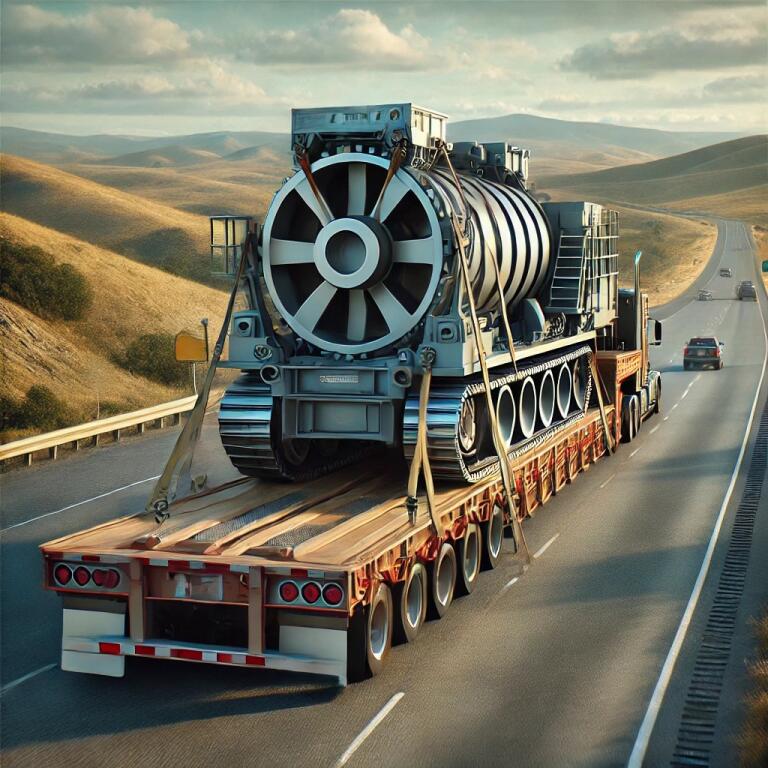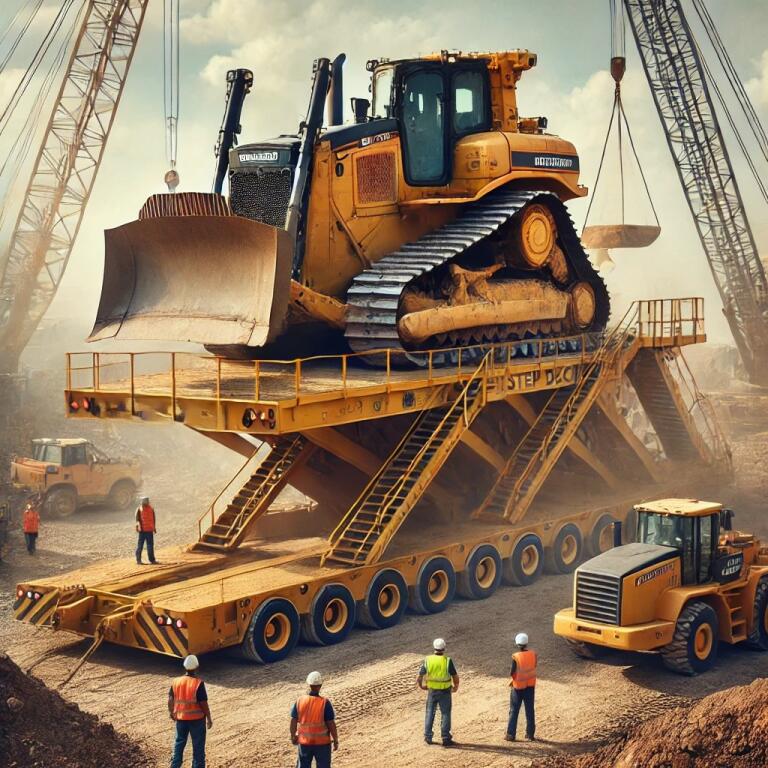
Heavy haul equipment is defined by its design and purpose for carrying loads exceeding typical weight and size limits. Understanding the characteristics of heavy loads is essential, as these unique shipments often require specially designed trailers and adhere to strict regulations to ensure safe passage on public roads.
Let's examine the different types of heavy haul equipment, the regulations needed for transport, and the importance of route planning in the heavy haul shipping process. By the end, you will gain an understanding of this equipment and how it plays a vital role in logistics today.

Definition of Heavy Haul Equipment
Heavy haul equipment refers to the specialized trailers and transport vehicles designed to move oversized loads or heavy hauls that exceed the standard legal load capacity. Common types of heavy haul equipment include:
- Heavy Haul Trailer: Built to accommodate heavy loads such as construction equipment, industrial machinery, and heavy equipment.
- Specialized Trailers: Customized for various heavy haul loads, including oversized and overweight loads.
- Step Deck Trailer: A drop deck with a lower deck is designed to transport taller pieces of equipment.
- Removable Gooseneck Trailers (RGN): Facilitates the transport of heavy machinery by allowing it to be driven onto the trailer.
- Additional Axles: Added to trailers to distribute the weight of oversized freight and meet legal road regulations.
Escort vehicles or pilot cars are often required to safely guide these heavy haul convoys, especially when the dimensions of the cargo exceed certain thresholds, such as height, which might impact navigation under power lines.
Heavy haulers must comply with regulations concerning oversized and overweight cargo to prevent infrastructure damage and ensure road safety.
Weight and Size Limitations
There are specific regulations in place to ensure safe travel over public roadways. These rules define the legal limits for dimensions and weight of heavy cargo, which vary by jurisdiction but are meticulously designed to prevent damage to road surfaces and bridges and ensure the overall safety of the heavy hauling process.
The typically acceptable weight limit for trucks in the United States is 80,000 pounds without special permits. However, obtaining permits for overweight loads is necessary for heavy haul equipment.
The size limitations generally include a maximum width of 8 feet 6 inches and a height limit of 13 feet 6 inches. Should the oversized cargo exceed these measurements, transportation departments require that transporters secure an oversized load permit.
Types of Cargo Commonly Transported
The types of cargo that require heavy haul equipment for transport are diverse and cover a broad spectrum of industries. Some of the most common types include:
- Construction Equipment: Bulldozers, cranes, and excavators are essential for construction projects.
- Industrial Machinery: Including manufacturing components, large-scale printers, and equipment used in production lines.
- Military Equipment: Encompassing tanks, trucks, and other large vehicles, as well as military construction equipment.
- Agricultural Machinery: Tractors, combines, and other large-scale farming equipment.
- Energy Sector Components include wind turbine blades, large transformers, and generator parts.
Moving these loads is a matter of capacity and expertise, as the heavy haul teams need to consider the weight distribution, securing of the load, and travel conditions to maintain safety throughout the transportation process.
Types of Trailers for Heavy Hauling
When transporting oversized or overweight cargo, the choice of trailer is paramount to ensure the heavy items are moved safely and efficiently. Various trailers with different weight capacities are designed to handle different kinds of heavy-haul loads.
Here, we'll explore the three common types: flatbed trailers, step deck trailers, and removable gooseneck trailers.
Flatbed Trailers
The flatbed is perhaps the most versatile type of trailer for transporting heavy equipment. Its open design, with no sides or roof, provides ease of loading and unloading heavy-haul loads. A typical flatbed trailer is around 48 to 53 feet long and can handle loads up to 8.5 feet wide.
Step Deck Trailers
Step deck trailers, also known as drop deck trailers, have a lower deck than the standard flatbed section. This design permits the transport of taller loads that wouldn't fit on a flatbed due to height restrictions. The upper deck is typically about 10 to 11 feet long, and the lower deck extends to about 37 to 40 feet, with a capacity to carry loads up to 10 feet high.

Removable Gooseneck Trailers
Removable gooseneck trailers (RGN) are specialized equipment for heavier loads. The detachable front sets RGN trailers apart, which allows the trailer to create a ramp for driving equipment directly onto the bed.
This is particularly useful for moving heavy construction equipment, industrial machinery, and military equipment without a crane.
This trailer type can have multiple axle configurations to handle extremely heavy or oversized loads. It comes in various lengths and is typically used for cargo that is over 8.5 feet in width and can be well over 10 feet in height, depending on the number of axles and legal limits.
Regulations and Permits for Heavy Haul Transport
Heavy haul transportation is subject to stringent regulations and permit requirements due to the potential risks and infrastructural challenges associated with moving heavy and oversized loads. Compliance with legal limits regarding weight, dimensions, and route planning is mandatory for heavy hauls.
Specialized equipment like heavy haul trailers, including step-deck and removable gooseneck trailers, are designed to accommodate the substantial size and weight of industrial machinery and other heavy items.
However, additional permits are necessary when these equipment pieces exceed standard legal limits. Moreover, overweight loads that surpass these limits may require the use of additional axles to distribute the load's weight properly.
The permits granted will reflect any specific precautions needed, including restrictions on the time of day when heavy-haul loads may be moved and any requirements for escort vehicles to ensure the safety and integrity of the operation.
Importance of Route Planning
When it comes to transporting heavy haul equipment, efficient and comprehensive route planning is crucial. This process ensures that oversized loads and heavy items reach their destinations on time while adhering to legal standards and avoiding unnecessary complications.
Route planning is essential because it dictates the course of the journey, considering variables like road accessibility, weight restrictions, and route clearance. It also influences the need for special travel permits and the deployment of escort vehicles to navigate traffic and other obstacles.
A well-designed route minimizes risks, reduces costs by avoiding delays, and enhances safety for the transport team and the general public.
Key Considerations for Choosing A Shipping Company
Selecting the right logistics partner for the transportation of heavy haul loads and oversized cargo is a decision that impacts both the immediate delivery and long-term reliability of businesses dealing with heavy items and specialized equipment.
Key aspects that must be considered include the prospective partner's experience, expertise, and the equipment they bring to the table. Working with a logistics company that understands the details of handling overweight loads, adheres to legal limits, and can safely maneuver long-distance heavy hauls is vital.

Final Thoughts on Heavy Haul Equipment
Heavy haul equipment plays a pivotal role in many industries where transporting heavy and oversized items is commonplace. Navigating the complexities of heavy hauling, including the regulations and logistical challenges, demands significant expertise.
Each piece of equipment must be meticulously selected based on the specifics of the cargo—its weight, dimensions, and the requirements for safe transit—to ensure compliance with regulations and safeguard against the risk of damage to the cargo or infrastructure.
Don’t let the worry of transporting overweight loads slow you down. A-1 Auto Transport provides escort vehicles for oversized load conveyance and operates with precision to avoid obstacles such as power lines.
We are equipped to deliver your specialized equipment wherever you need it. Choose us for your transportation needs, and let us carry the heavy load. Contact A-1 Auto Transport today for your free quote!






 Share on Facebook
Share on Facebook Share on LinkedIn
Share on LinkedIn Share on Twitter
Share on Twitter




 Google
Google  Instagram
Instagram  Trustpilot
Trustpilot 



